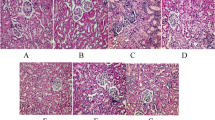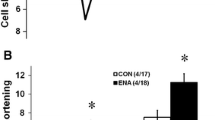Abstract
In end-stage heart failure due to idiopathic dilated cardiomyopathy β1-adrenoceptors are downregulated and G1α-proteins are upregulated. The aim of the present study was to investigate the influence of the angiotensin-converting enzyme inhibitor captopril on β-adrenoceptor density and Giα-proteins in sequential endomyocardial biopsies. Nineteen patients with mild to moderate congestive heart failure due to idiopathic dilated cardiomyopathy (NYHA Class II–III) were studied before and after 8–11 weeks of therapy. Patients were randomised into a captopril and a control group; 9 patients received captopril 12.5–50 mg per day, (divided in 2–3 doses) p.o. in addition to “conventional” therapy with digoxin and diuretics, and 10 controls received “conventional” therapy only. Echocardiography, spiroergometry, right heart catheterisation and endomyocardial biopsies were performed before (baseline) and after treatment. Compared to baseline, captopril increased total β-adrenoceptor density by selectively increasing β1-adrenoceptors (31.6 vs 41.2 fmol·mg−1; p<0.05) but had no significant effect on Giα-proteins. The results indicate that treatment with angiotensin-converting enzyme inhibitors partly restores myocardial β1-adrenoceptor density, and this action effect may contribute to the clinical improvement of patients with idiopathic dilated cardiomyopathy treated in this way.
Similar content being viewed by others
References
Captopril Multicenter Research Group (1983) A placebo-controlled trial of captopril in refractory chronic congestive heart failure. J Am Coll Cardiol 2: 755–763
The CONSENSUS Trial Study Group (1987) Effects of enalapril on mortality in severe congestive heart failure: results of the Cooperative North Scandinavian Enalapril Survival Study (CONSENSUS). N Engl J Med 316: 1429–1435
Pfeffer MA, Lamas GA, Vaughan DE, Parisi AF, Braunwald E (1988) Effect of captopril on progressive ventricular dilatation after anterior myocardial infarction. N Engl J Med 319: 80–86
The SOLVD Investigators (1991) Effect of enalapril on survival in patients with reduced left ventricular ejection fractions and congestive heart failure. N Engl J Med 325: 293–302
Cohn JN, Johnson G, Ziesche S, Cobb F, Francis G, Tristani F, Smith R, Dunkman WB, Loeb H, Wong M, Bhat G, Goldman S, Fletcher RD, Doherty J, Hughes CV, Carson P, Cintron G, Shabetal R, Haakenson C (1991) A comparison of enalapril with hydralazine-isosorbide dinitrate in the treatment of chronic congestive heart failure. N Engl J Med 325: 303–310
The SOLVD Investigators (1992) Effect of enalapril on mortality and the development of heart failure in asymptomatic patients with reduced left ventricular ejection fractions. N Engl J Med 327: 685–691
The SAVE Investigators (1992) Effect of captopril on mortality and morbidity in patients with left ventricular dysfunction after myocardial infarction. N Engl J Med 327: 669–677
The AIRE Investigators (1993) Effect of ramipril on mortality and morbidity of survivors of acute myocardial infarction with clinical evidence of heart failure. Lancet 342: 821–882
Feldman MD, Copelas L, Gwathmey JK, Phillips P, Warren SE, Schoen FJ, Grossman W, Morgan JP (1987) Deficient production of cyclic AMP: pharmacologic evidence of an important cause of contractile dysfunction in patients with end-stage heart failure. Circulation 75: 331–339
Bristow MR, Ginsburg R, Minobe W, Cubicciotti RS, Sageman WS, Lurie K, Billingham ME, Harrison DC, Stinson EB (1982) Decreased catecholamine sensitivity and β-adrenergic-receptor density in failing human hearts. N Engl J Med 307: 205–211
Schmitz W, Scholz H, Erdmann E (1987) Effects of α-and β-adrenergic agonists, phosphodiesterase inhibitors and adenosine on isolated human heart muscle preparations. Trends Pharmacol Sci 8: 447–450
Danielson W, Leyen vd H, Meyer W, Neumann J, Schmitz W, Scholz H, Starbatty J, Stein B, Döring V, Kalmár P (1989) Basal and isoprenaline-stimulated cAMP content in failing versus nonfailing human cardiac preparations. J Cardiovasc Pharmacol 14: 171–173
Fowler MB, Laser JA, Hopkins GL, Minobe W, Bristow MR (1986) Assessment of the β-adrenergic receptor pathway in the intact failing human heart: progressive receptor down-regulation and subsensitivity to agonist response. Circulation 74: 1290–1302
Brodde OE, Zerkowski HR, Borst HG, Maier W, Michel MC (1989) Drug- and disease-induced changes of human cardiac β1-and β2-adrenoceptors. Eur Heart J 10 [Suppl B]: 38–44
Feldman AM, Cates AE, Veazey WB, Hershberger RE, Bristow MR, Baughman KL, Baumgartner WA, Van Dop C (1988) Increase in the 40,000-mol wt pertussis toxin substrate (G-protein) in the failing human heart. J Clin Invest 82: 189–197
Neumann J, Schmitz W, Scholz H, von Meyerinck L, Döring V, Kalmár P (1988) Increase of myocardial Gi-proteins in heart failure. Lancet II: 936–937
Böhm M, Gierschik P, Jakobs KH, Pieske B, Schnabel P, Ungerer M, Erdmann E (1990) Increase of Giα in human hearts with dilated but not ischemic cardiomyopathy. Circulation 82: 1249–1265
Beaver WL, Wassermann K, Whipp BJ (1986) A new method for detecting anaerobic threshold by gas exchange. J Appl Physiol 60: 2020–2027
Ray J, Hosenpud J (1990) Endomyocardial biopsy: techniques and interpretation of rejection. In: Hosenpud JD, Cobanoglu A, Norman DJ, Starr A (eds) Cardiac transplantation. A manual for health care professionals. Springer, Berlin Heidelberg New York, pp 115–127
Brodde OE, Khamssi M, Zerkowski HR (1991) β-Adrenoceptors in the transplanted heart: unaltered β-adrenoceptor density, but increased proportion of β2-adrenoceptors with increasing posttransplant time. Naunyn-Schmiedeberg's Arch Pharmacol 344: 430–436
Steinfath M, Geertz B, Schmitz W, Scholz H, Haverich A, Breil I, Hanrath P, Reupcke C, Sigmund M, Lo HB (1991) Distinct down-regulation of cardiac β1- and β2-adrenoceptors in different human heart diseases. Naunyn-Schmiedeberg's Arch Pharmacol 343: 217–220
Ribeiro-Neto F, Mattera R, Grenet D, Sekura RD, Birnbaumer L, Field JB (1987) Adenosine diphosphate ribosylation of G-proteins by pertussis and cholera toxin in isolated membranes. Different requirements for and effects of guanine nucleotides and Mg2+. Mol Endocrinol 1: 472–481
Mende U, Eschenhagen T, Geertz B, Schmitz W, Scholz H, Schulte am Esch J, Sempell R, Steinfath M (1992) Isoprenaline-induced increase in the 40/41 kDa pertussis toxin substrates and functional consequences on contractile response in rat heart. Naunyn-Schmiedeberg's Arch Pharmacol 345: 44–50
Laemmli UK (1970) Cleavage of structural proteins during assembly of the head of bacteriophage T4. Nature 227: 680–685
Scatchard G (1949) The attraction of proteins for small molecules and ions. Ann NY Acad Sci 51: 660–672
Gilbert EM, Sandoval A, Larrabee P, Renlund DG, O'Connell JB, Bristow MR (1993) Lisinopril lowers cardiac adrenergic drive and increases β-receptor density in the failing human heart. Circulation 88: 472–480
Bristow MR, Ginsburg R, Umans V, Fowler M, Minobe W, Rasmussen R, Zera P, Menlove R, Shah P, Jamieson S, Stinson EB (1986) β1- and β2-Adrenergic-receptor subpopulations in nonfailing and failing human ventricular myocardium: coupling of both receptor subtypes to muscle contraction and selective β1-receptor downregulation in heart failure. Circ Res 59: 297–309
Horn EM, Corwin SJ, Steinberg SF, Chow YK, Neuberg GW, Cannon PJ, Powers ER, Bilezikian JP (1988) Reduced lymphocyte stimulatory guanine nucleotide regulatory protein and β-adrenergic receptors in congestive heart failure and reversal with angiotensin-converting enzyme inhibitor therapy. Circulation 78: 1373–1379
Maisel AS, Harris T, Rearden CA, Michel MC (1990) β-Adrenergic receptors in lymphocyte subsets after exercise: alterations in normal individuals and patients with congestive heart failure. Circulation 82: 2003–2010
Cody RJ, Franklin KW, Kluger J, Laragh JH (1982) Sympathetic responsiveness and plasma norepinephrine during therapy of chronic congestive heart failure with captopril. Am J Med 72: 791–797
Author information
Authors and Affiliations
Rights and permissions
About this article
Cite this article
Jakob, H., Eschenhagen, T., Mende, U. et al. Effect of captopril on myocardial β-adrenoceptor density and Giα-proteins in patients with mild to moderate heart failure due to dilated cardiomyopathy. Eur J Clin Pharmacol 47, 389–394 (1995). https://doi.org/10.1007/BF00196850
Received:
Accepted:
Issue Date:
DOI: https://doi.org/10.1007/BF00196850




